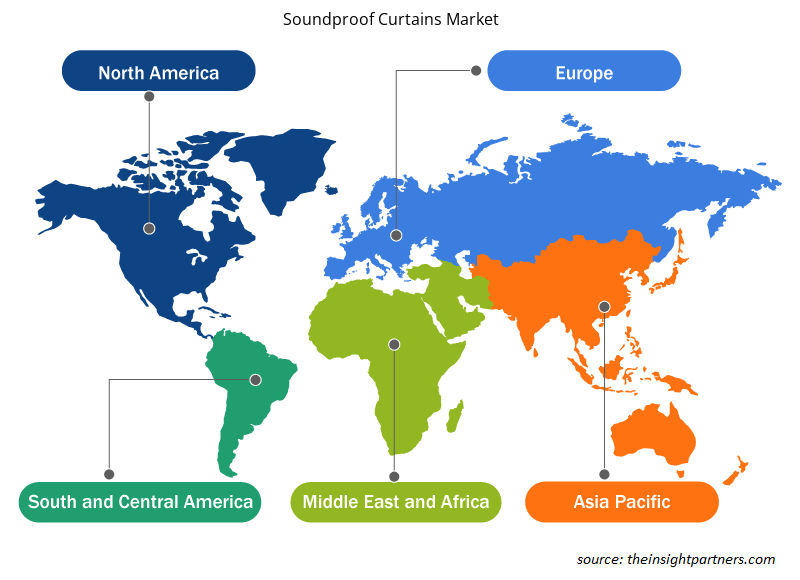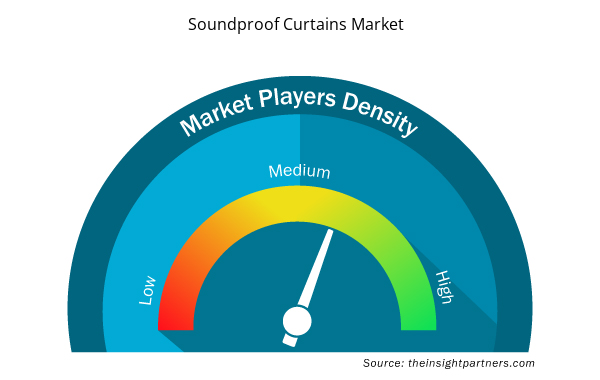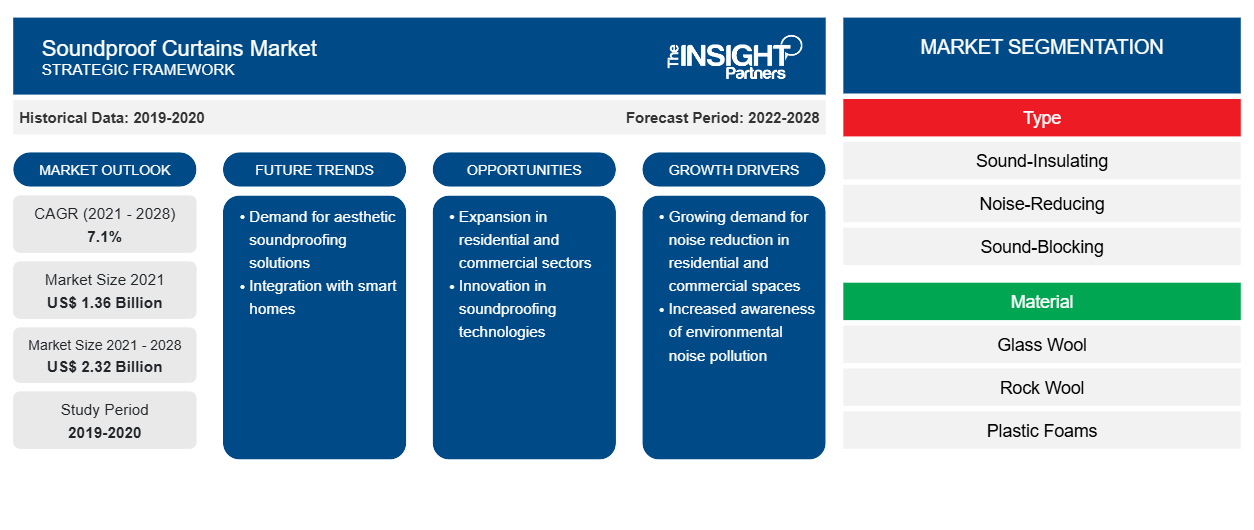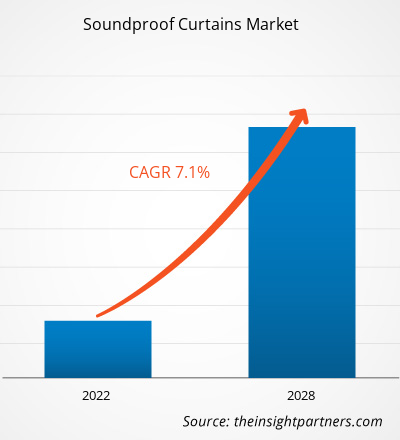2020 年隔音窗帘市场价值为 13.5621 亿美元,预计到 2028 年将达到 23.1806 亿美元;预计 2021 年至 2028 年的复合年增长率为 7.1%。
隔音窗帘旨在通过阻挡声音进入设施来解决噪音污染问题。窗帘还用于通过减少混响和提供更清晰的声音来防止室内回声。它们易于安装,维护成本低,并提供隔热效果。隔音窗帘由各种材料制成,例如玻璃棉、岩棉、塑料泡沫、天然纤维等。这些窗帘通常比传统窗帘更长更重,可使产品覆盖最大面积以减少进入的声音。据专家称,打开 1% 的区域可能会让多达 50% 的声源声音进入。
2020 年,亚太地区占据了全球隔音窗帘市场的最大份额。亚太地区市场的增长主要归因于该地区的人口增长。仅新兴经济体中国和印度就占全球人口的 35% 以上。此外,该地区各种制造商的存在也为亚太地区的市场增长做出了重大贡献。原材料的易得性和可用性,加上廉价的劳动力和低廉的生产成本,为该地区的制造商和希望扩张的全球参与者提供了丰厚的机会。
由于封锁、旅行禁令和企业停工,COVID-19 疫情对各国的经济和行业产生了不利影响。全球化学品和材料行业是遭受严重破坏的主要行业之一,例如供应链中断、技术活动取消和办公室关闭。尽管中国是全球制造业中心和各行业最大的原材料供应国,但也是受影响最严重的国家之一。中国各工厂的封锁限制了全球供应链,扰乱了制造活动、交货计划以及各种化学品和材料的销售。多家公司已经宣布产品交付可能延迟,未来产品销售下滑。此外,欧洲、亚洲和北美国家实施的全球旅行禁令阻碍了商业合作和伙伴关系机会。所有这些因素都阻碍了化学品和材料行业的发展,从而抑制了与该行业相关的各个市场的增长。
定制此报告以满足您的需求
您可以免费定制任何报告,包括本报告的部分内容、国家级分析、Excel 数据包,以及为初创企业和大学提供优惠和折扣
- 获取此报告的关键市场趋势。这个免费样品将包括数据分析,从市场趋势到估计和预测。
市场洞察
各行各业对隔音或声绝缘材料的需求不断增加
隔音窗帘有助于控制光线和声音混响,从而优化空间。它主要由吸音玻璃纤维、岩棉、塑料泡沫和其他材料制成。隔音窗帘市场的增长受到住宅和非住宅建筑活动的增加、工业自动化的提高以及窗帘设计的创新的推动。对无噪音环境的需求不断增加,主要是医院等养老院,以及商业部门(包括医院、购物中心、机场和电影院)的快速扩张,增加了对隔音窗帘的需求。此外,由于老年人口的增加,亚太地区新医疗设施的建设不断增加,这将进一步促进市场增长。商业部门报告称,由于玻璃棉保温材料比同类材料具有更好的声学性能,因此被广泛采用。此外,工业部门非常需要在泵、真空吸尘器、压缩机和发电机等噪音大的设备周围安装隔音屏,以确保隔音效果。因此,医疗保健、商业、工业和住宅等领域对隔音材料的需求不断增长,引发了隔音窗帘的采用,从而推动了市场增长。
类型洞察
根据类型,隔音窗帘市场分为隔音、降噪和隔音。降噪部分在 2020 年占据了最大的市场份额。噪音控制窗帘系统是根据消费者的声学性能和结构完整性应用而定制设计的产品。隔音窗帘是一种经济高效的解决方案,可用于减少不必要的噪音。大多数公司提供创新产品,主要用于控制噪音和振动。公司提供创新产品和解决方案来控制空气噪音、增强室内声学效果、隔离结构振动、创造安静空间和抑制非结构建筑系统。隔音屏障复合材料是一种薄、高性能、坚固、灵活的隔音被子窗帘和乙烯基复合材料,旨在解决必须增加吸音和隔音效果的噪音控制应用。隔音窗帘中采用隔音膜、隔音矿棉空腔隔热材料、玻璃纤维、弹性通道、隔音吊架(支架)、隔音石膏板(石膏板)等作为降噪材料。
隔音窗帘市场的一些主要市场参与者是 Acoustical Surfaces, Inc.;Amcraft Manufacturing, Inc.;eNoise Control;Flexshield Group Pty, Ltd.;Great Lakes Textiles;Hofa-Akustik;Kinetics Noise Control, Inc.;Sound Seal;Steel Guard Safety Products, Inc.;和 Quiet Curtains。市场的主要参与者正专注于并购和产品发布等战略,以扩大全球地理影响力和消费者基础。
报告亮点
- 全球隔音窗帘市场的渐进式行业趋势,帮助参与者制定有效的长期战略
- 发达市场和发展中市场采用的业务增长战略
- 2017年至2028年全球隔音窗帘市场定量分析
- 各行业隔音窗帘需求量估算
- PEST 分析可说明行业内买家和供应商预测市场增长的有效性
- 了解竞争激烈的市场形势和隔音窗帘的需求的最新发展
- 市场趋势和前景以及推动和抑制隔音窗帘市场增长的因素
- 通过了解支撑全球隔音窗帘市场增长的商业利益的策略来做出决策
- 隔音窗帘市场各节点规模
- 全球隔音窗帘市场的详细概述和细分以及行业动态
- 隔音窗帘市场各地区规模及增长机遇
隔音窗帘市场区域洞察
Insight Partners 的分析师已详尽解释了预测期内影响隔音窗帘市场的区域趋势和因素。本节还讨论了北美、欧洲、亚太地区、中东和非洲以及南美和中美洲的隔音窗帘市场细分和地理位置。

- 获取隔音窗帘市场的区域特定数据
隔音窗帘市场报告范围
| 报告属性 | 细节 |
|---|---|
| 2021 年市场规模 | 13.6亿美元 |
| 2028 年市场规模 | 23.2亿美元 |
| 全球复合年增长率(2021 - 2028) | 7.1% |
| 史料 | 2019-2020 |
| 预测期 | 2022-2028 |
| 涵盖的领域 | 按类型
|
| 覆盖地区和国家 | 北美
|
| 市场领导者和主要公司简介 |
|
市场参与者密度:了解其对商业动态的影响
隔音窗帘市场正在快速增长,这得益于终端用户需求的不断增长,而这些需求又源于消费者偏好的不断变化、技术进步以及对产品优势的认识不断提高等因素。随着需求的增加,企业正在扩大其产品范围,进行创新以满足消费者的需求,并利用新兴趋势,从而进一步推动市场增长。
市场参与者密度是指在特定市场或行业内运营的企业或公司的分布情况。它表明在给定市场空间中,相对于其规模或总市场价值,有多少竞争对手(市场参与者)存在。
在隔音窗帘市场运营的主要公司有:
- 声学表面公司
- Amcraft 制造有限公司
- 噪音控制
- Flexshield 集团有限公司
- 大湖纺织品
免责声明:上面列出的公司没有按照任何特定顺序排列。

- 了解隔音窗帘市场的主要参与者概况
隔音窗帘市场(按类型)
- 隔音
- 降低噪音
- 隔音
隔音窗帘市场(按材料划分)
- 玻璃棉
- 岩棉
- 塑料泡沫
- 天然纤维
隔音窗帘市场(按最终用户划分)
- 住宅
- 商业的
- 工业的
公司简介
- 声学表面公司
- Amcraft 制造有限公司
- 噪音控制
- Flexshield 集团有限公司
- 大湖纺织品
- 霍法阿库斯蒂克
- 动力噪声控制有限公司
- 隔音密封
- 钢铁卫士安全产品有限公司
- 静音窗帘
- 历史分析(2 年)、基准年、预测(7 年)及复合年增长率
- PEST 和 SWOT 分析
- 市场规模价值/数量 - 全球、区域、国家
- 行业和竞争格局
- Excel 数据集



Report Coverage
Revenue forecast, Company Analysis, Industry landscape, Growth factors, and Trends

Segment Covered
This text is related
to segments covered.

Regional Scope
North America, Europe, Asia Pacific, Middle East & Africa, South & Central America

Country Scope
This text is related
to country scope.
常见问题
The major players operating in the global soundproof curtains market are Acoustical Surfaces, Inc., Amcraft Manufacturing, Inc., eNoise Control, Flexshield Group Pty, Ltd., Great Lakes Textiles, Hofa-Akustik, Kinetics Noise Control, Inc., Sound Seal, Steel Guard Safety Products, Inc., Quiet Curtains., among others.
In 2020, Asia Pacific accounted for the largest share of the global soundproof curtain market. The growth of the soundproof curtain market in this region is primarily attributed to the population expansion in the region. Emerging economies, China and India alone account for over 35% of the global population. In addition to this, the presence of various manufacturers in the region have also contributed significantly to the growth of the market in Asia Pacific. The easy accessibility and availability of raw materials coupled with cheap labor and low production costs offer lucrative opportunities for manufacturers in the region as well as global players that wish to expand.
The noise reducing segment led the soundproof curtains market with the largest market share in 2020. Noise control curtain systems are products that custom engineered to the consumer's application for acoustic performance and structural integrity. These curtains are a cost-effective solution that can be used to reduce unwanted noise. Most of the companies offer innovative products which are mostly used to control noise and vibration. Companies offer innovative products as well as solutions to control airborne noise, enhance room acoustics, isolate structure-borne vibration, create quiet spaces, and restrain non-structural building systems. Noise barrier composites are curtains that are thin, high-performing, rugged, flexible acoustical quilt and vinyl composites that are designed to solve noise control applications where sound absorption and sound blocking must be increased. Acoustic membrane, acoustic mineral wool cavity insulation, fiberglass, resilient channels, acoustic hangers (mounts), soundproof drywall (plasterboard), and others are utilized as noise-reducing material in noise-reducing curtains.
The List of Companies - Soundproof Curtains Market
- Acoustical Surfaces, Inc.
- Amcraft Manufacturing, Inc.
- eNoise Control
- Flexshield Group Pty, Ltd.
- Great Lakes Textiles
- Hofa-Akustik
- Kinetics Noise Control, Inc.
- Sound Seal
- Steel Guard Safety Products, Inc.
- Quiet Curtains
The Insight Partners performs research in 4 major stages: Data Collection & Secondary Research, Primary Research, Data Analysis and Data Triangulation & Final Review.
- Data Collection and Secondary Research:
As a market research and consulting firm operating from a decade, we have published and advised several client across the globe. First step for any study will start with an assessment of currently available data and insights from existing reports. Further, historical and current market information is collected from Investor Presentations, Annual Reports, SEC Filings, etc., and other information related to company’s performance and market positioning are gathered from Paid Databases (Factiva, Hoovers, and Reuters) and various other publications available in public domain.
Several associations trade associates, technical forums, institutes, societies and organization are accessed to gain technical as well as market related insights through their publications such as research papers, blogs and press releases related to the studies are referred to get cues about the market. Further, white papers, journals, magazines, and other news articles published in last 3 years are scrutinized and analyzed to understand the current market trends.
- Primary Research:
The primarily interview analysis comprise of data obtained from industry participants interview and answers to survey questions gathered by in-house primary team.
For primary research, interviews are conducted with industry experts/CEOs/Marketing Managers/VPs/Subject Matter Experts from both demand and supply side to get a 360-degree view of the market. The primary team conducts several interviews based on the complexity of the markets to understand the various market trends and dynamics which makes research more credible and precise.
A typical research interview fulfils the following functions:
- Provides first-hand information on the market size, market trends, growth trends, competitive landscape, and outlook
- Validates and strengthens in-house secondary research findings
- Develops the analysis team’s expertise and market understanding
Primary research involves email interactions and telephone interviews for each market, category, segment, and sub-segment across geographies. The participants who typically take part in such a process include, but are not limited to:
- Industry participants: VPs, business development managers, market intelligence managers and national sales managers
- Outside experts: Valuation experts, research analysts and key opinion leaders specializing in the electronics and semiconductor industry.
Below is the breakup of our primary respondents by company, designation, and region:

Once we receive the confirmation from primary research sources or primary respondents, we finalize the base year market estimation and forecast the data as per the macroeconomic and microeconomic factors assessed during data collection.
- Data Analysis:
Once data is validated through both secondary as well as primary respondents, we finalize the market estimations by hypothesis formulation and factor analysis at regional and country level.
- Macro-Economic Factor Analysis:
We analyse macroeconomic indicators such the gross domestic product (GDP), increase in the demand for goods and services across industries, technological advancement, regional economic growth, governmental policies, the influence of COVID-19, PEST analysis, and other aspects. This analysis aids in setting benchmarks for various nations/regions and approximating market splits. Additionally, the general trend of the aforementioned components aid in determining the market's development possibilities.
- Country Level Data:
Various factors that are especially aligned to the country are taken into account to determine the market size for a certain area and country, including the presence of vendors, such as headquarters and offices, the country's GDP, demand patterns, and industry growth. To comprehend the market dynamics for the nation, a number of growth variables, inhibitors, application areas, and current market trends are researched. The aforementioned elements aid in determining the country's overall market's growth potential.
- Company Profile:
The “Table of Contents” is formulated by listing and analyzing more than 25 - 30 companies operating in the market ecosystem across geographies. However, we profile only 10 companies as a standard practice in our syndicate reports. These 10 companies comprise leading, emerging, and regional players. Nonetheless, our analysis is not restricted to the 10 listed companies, we also analyze other companies present in the market to develop a holistic view and understand the prevailing trends. The “Company Profiles” section in the report covers key facts, business description, products & services, financial information, SWOT analysis, and key developments. The financial information presented is extracted from the annual reports and official documents of the publicly listed companies. Upon collecting the information for the sections of respective companies, we verify them via various primary sources and then compile the data in respective company profiles. The company level information helps us in deriving the base number as well as in forecasting the market size.
- Developing Base Number:
Aggregation of sales statistics (2020-2022) and macro-economic factor, and other secondary and primary research insights are utilized to arrive at base number and related market shares for 2022. The data gaps are identified in this step and relevant market data is analyzed, collected from paid primary interviews or databases. On finalizing the base year market size, forecasts are developed on the basis of macro-economic, industry and market growth factors and company level analysis.
- Data Triangulation and Final Review:
The market findings and base year market size calculations are validated from supply as well as demand side. Demand side validations are based on macro-economic factor analysis and benchmarks for respective regions and countries. In case of supply side validations, revenues of major companies are estimated (in case not available) based on industry benchmark, approximate number of employees, product portfolio, and primary interviews revenues are gathered. Further revenue from target product/service segment is assessed to avoid overshooting of market statistics. In case of heavy deviations between supply and demand side values, all thes steps are repeated to achieve synchronization.
We follow an iterative model, wherein we share our research findings with Subject Matter Experts (SME’s) and Key Opinion Leaders (KOLs) until consensus view of the market is not formulated – this model negates any drastic deviation in the opinions of experts. Only validated and universally acceptable research findings are quoted in our reports.
We have important check points that we use to validate our research findings – which we call – data triangulation, where we validate the information, we generate from secondary sources with primary interviews and then we re-validate with our internal data bases and Subject matter experts. This comprehensive model enables us to deliver high quality, reliable data in shortest possible time.


 获取此报告的免费样本
获取此报告的免费样本